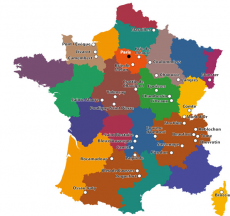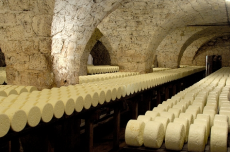
Email: nadege.preston@hotmail.com
Total Article : 82
About Me:Hi I’m Nadege and I study French at the University of Leeds, and I have just completed my third year abroad in Montpellier studying literature and enjoying the sunshine! I love art; painting and being creative, as well as photography and baking. Travelling is my favourite hobby at the moment; experiencing the French language and culture. I hope you enjoy reading some of my articles!

This category, about the French culture, has to be the only category in which you will find an article written about cheese. Cheese, as many of you know, is one of France’s delicacies which are a vital part of French cuisine and French culture. How could the French survive without wine and cheese after all?
I have included a map of France in IMAGE 1 which explains where the different types of French cheeses are made. However, as the image is small, you may want to take a look at the website;
http://www.france-pub.com/cheese/french-cheese-map.html
The most common of French cheese are Brie, Camembert, Roquefort and Comté. Franche-Comté is in fact the name of the French region where Comté is made, and this is where it gets its name from. Most French cheeses also take their name from the city, town, village or region in which they are made.

Camembert is actually a village in Normandy, in which a Président Farm is open, to show visitors how the Camembert cheese in made. There is also ‘La Maison du Camembert’ which is a house split into two parts; one being a museum, and the other being a tasting area. The architecture for this ‘Maison’ resembles a Camembert cheese, slightly open, as it is round and white. Additionally, Brie was a historic region in northern France, and it was formed from the modern departments Champagne-Ardenne and Marne which once formed eastern Brie, the department of Seine-et-Marne which formed western Brie and northern Brie being formed by the modern department of Aisne. Brie de Meaux and Brie de Melun are both different types of Brie, which are produced in the modern day Île de France region, otherwise known as the Parisian region. I village I have visited myself is the Roquefort village in the Languedoc-Roussillon region in southern France and here you are able to take a tour of the Roquefort caves, to find out about how the cheese is matured. After the collapse of the Combalou mountain, the caves were formed naturally and the cellars were organised to mature the Roquefort cheeses through ventilation. There are the caves of Roquefort Société and Roquefort Papillon which are two different caves, for the different producers and it is mind-blowing how many individual cheeses there are kept in each cave, which are almost like labyrinths as you walk through. A legend is told that the Roquefort cheese was first discovered by a youth who was eating some plain cheese, made by ewe’s milk, and when he noticed a beautiful girl, he left to meet with her whilst abandoning his cheese that he left in the cave. Upon his return, his cheese has turned into Roquefort (which takes around 3 months to age) as it had turned moldy – but tasted even more delicious!
Every region in France produces its own cheeses, and they are all, in my opinion, the best cheese you will ever eat. They beat Cheddar any day, especially eaten with a warm baguette! The former President of France, Charles de Gaulle, once stated; "Comment voulez-vous gouverner un pays qui a deux cent quarante-six variétés de fromage?" ("How can you govern a country which has two hundred and forty-six varieties of cheese?") (Les Mots du Général, Ernest Mignon, 1962). Hopefully you now have more of an insight as to why France is globally well-known for its cheeses, and why cheese is of such importance to French people and their cuisine.
IMAGE 1 URL
http://www.france-pub.com/maps/map-cheese-600.jpg
IMAGE 2 URL Roquefort Caves
http://www.cantobre-france.eu/wp-content/uploads/2012/02/Roquefort_Caves.jpg

0 Comment:
Be the first one to comment on this article.